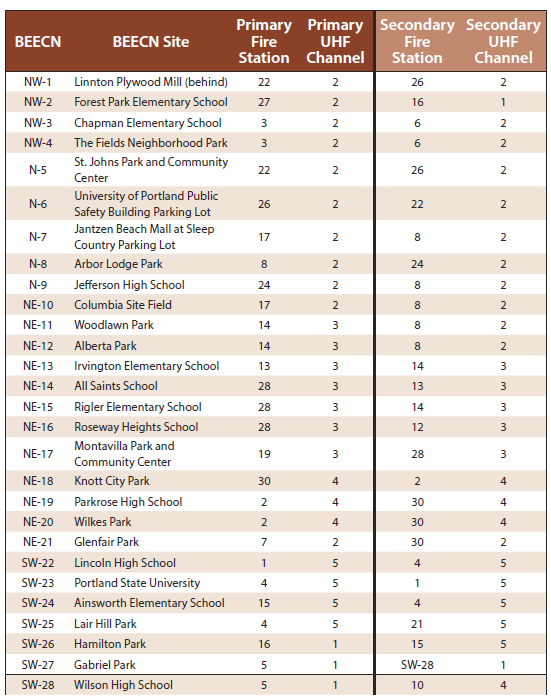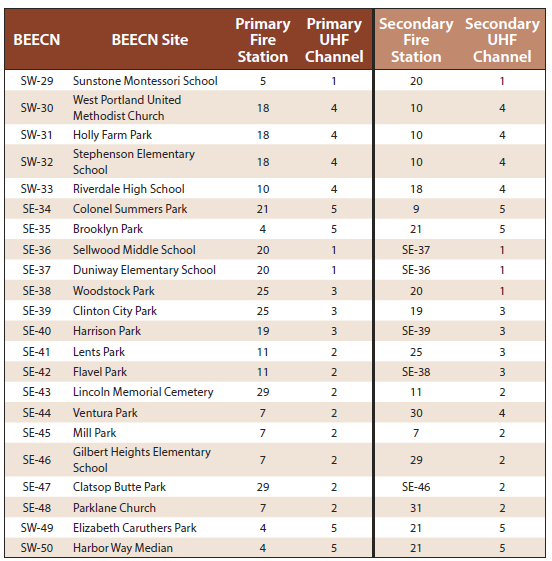Operations at BEECN Sites
This section steps volunteers through what to do when deployed to a BEECN in an emergency or during an exercise. Operations for volunteers who deploy to fire stations to support BEECNs are covered inSection 400.
300.05 Deployment Planning
Have a plan. Cohorts must consider that an earthquake knocking out communications systems means volunteers will be unable to check in with each other. Therefore, cohorts must plan ahead on who deploys for Shift A, and who for Shift B.
Furthermore, all four volunteers (Primary and Backup) assigned to a shift should deploy for that shift if they can. If one or both Primary volunteers cannot deploy, the Backup volunteers are still present to carry out BEECN responsibilities and/or assist the Primary Volunteers if needed. Backup volunteers can also rotate Primary Volunteers out of their shift for breaks to eat, use the bathroom, etc.
PBEM recommends that the Cohort Coordinator inform the closest Fire Station and local NETs of the Cohort’s deployment plan.
300.10 BEECN Operational Periods and Shifts
a. The operational period for a BEECN is from 0600 to 2200, and BEECNs will not operate from 2200 to 0600 (with the next operational period starting at 0600); unless otherwise specified by PBEM.
b. Each operational period is divided into two shifts: Shift A and Shift B. Shift A runs from 0600 to 1400, and Shift B runs from 1400 to 2200.
300.15 Deployment Protocols
The radio network for BEECNs is activated 24 to 48 hours following a catastrophic earthquake that has shut down communications systems such as cell phones and landlines. Therefore, BEECN volunteers must expect to self deploy without a direct request from PBEM or other government authority. Volunteers should self-deploy to the BEECN cache and set up at the BEECN site if, and only if, the following conditions are met:
a. A major earthquake has occurred in the Portland area.
b. The volunteer and his or her family are not in any immediate danger, and are not injured.
c. Communication systems (such as land lines) are inoperative.
d. Volunteers have received no direct instructions from PBEM or other government authority.
300.20 Responsibilities Prior to Deployment
Immediately following an earthquake, BEECN volunteers:
a. Check themselves for injuries and ensure personal safety.
b. Check in with household members, ensure their safety, and treat any injuries.
c. Deploy to BEECN cache if it is safe to do so, and set it up at the BEECN site.
300.25 Self Determination to Deploy
Individual volunteers maintain personal discretion to deploy when the self- deployment protocols are met as described in 300.15. The decision to deploy following a disaster is a volunteer’s own, and a volunteer may never be coerced into deploying. A volunteer who chooses not to deploy will not be subject to any consequences related to his or her standing in the BEECN program.
300.30 Deployment Guiding Principles
During the course of any deployment or exercise, BEECN volunteers must ensure that all chosen actions conform to the following guiding principles:
Page 32 of 58 Page last updated: April 9, 2019 1:02 PM
a. Safety is always the top priority.
b. Always use the buddy system and always work in pairs. It takes at least two volunteers to operate a BEECN.
c. If you see something unsafe, say so. Everyone has permission to say, “That does not seem safe” or “I do not feel safe.”
d. If someone points out an unsafe condition, stop and correct it right away.
e. The loaded cache carts weigh approximately 250 pounds. Always use two people to move them.
300.35 Conduct at the BEECN Cache and Site
When moving the BEECN cache and setting up at the site, volunteers should act as guests on the property. Please be respectful and avoid damaging the grounds or any property at the location. If a property owner is present, or a representative of the property owner, volunteers should follow instructions given by that person. Please represent Portland professionally and respectfully.
300.40 Personal Security
a. Volunteers must never carry firearms or other weapons when volunteering at a BEECN. A folding knife or knife with less than a twelve-inch blade is acceptable as a tool.
b. If confronted by a person at any time who intends to take the equipment and/or harm the volunteers, volunteers must not engage physically or verbally. Leave the equipment and walk away,and call out for help. Do not attempt to confront any threatening person.
300.45 BEECN Set Up
a. Push the cache to a set up location at the BEECN site that is:
- At least 12’ x 12’ in area
- Level
- Not under trees or power lines
- Away from tall buildings and any brick or block structures
b. Unlock/open cache and do a brief inventory of the contents (except for inside the First Aid bags).
c. Set up the tent using the Tent Instructions on XXXXX.
d. Load batteries into the radio and turn the radio on. See page 19 for instructions.
e. Turn the radio to your assigned radio channel according to 300.50: Channel Guide.
f. Use the script in Section 300.55 to check in with your station and begin passing radio traffic.
g. Record the messages you receive in the RADIO LOG included in the binder.
300.50 BEECN Channel Guide
300.55 Radio Script for BEECN Check In
Script legend: Variable text in {bracketed italics}, and spoken words in plain text.
Radio scripts for BEECN to fire station: Follow this script to notify your nearby Fire Station that you are set up and ready to communicate.
- BEECN VOLUNTEER: {FIRE STATION NUMBER} this is {BEECN NUMBER and BEECN NAME} checking in.
- FIRE STATION: Roger {BEECN NUMBER and BEECN NAME}. Are you at BEECN and ready to operate?

